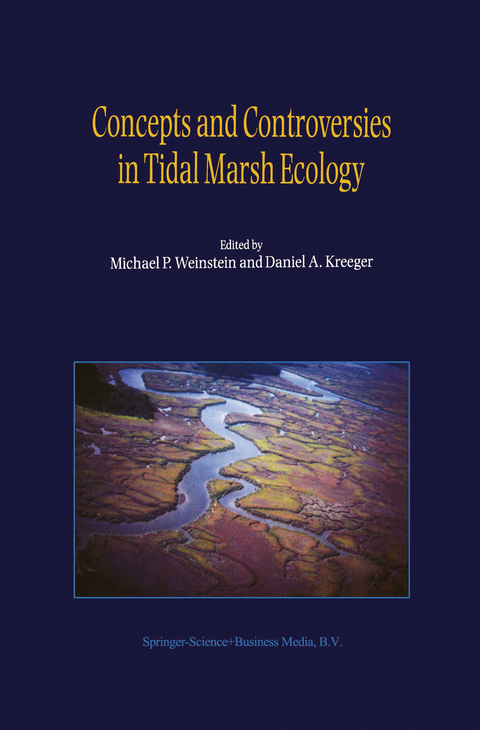
Concepts and Controversies in Tidal Marsh Ecology
Kluwer Academic Publishers (Hersteller)
978-0-306-47534-4 (ISBN)
- Keine Verlagsinformationen verfügbar
- Artikel merken
Foreword. Dedication. Preface. Retrospective on the Salt Marsh Paradigm. Tidal marshes as outwelling/pulsing systems; E.P. Odum. Salt marsh values: etrospection from the end of the century; J.M. Teal, B.L. Howes. Sources and Patterns of Production. Role of salt marshes as part of coastal landscapes; I. Valiela, et al. Spatial variation in process and pattern in salt marsh plant communities in eastern North America; M.D. Bertness, S.C. Pennings. Eco-physiological controls on the productivity of Spartina alterniflore; I.A. Menselssohn, J.T. Morris. Community structure and functional dynamics of benthic microalgae in salt marshes; M.J. Sullivan, C.A. Currin. Structure and productivity of microtidal Mediterranean coastal marshes; C. Ibañez, et al. Development and structure of salt marshes: community patterns in time and space; A.J. Davy. Fate of Production Within Marsh Food Webs. Microbial secondary production from salt marsh-grass shoots, and its known and potential fates; S.Y. Newell, D. Porter. Trophic complexity between producers and invertebrate consumers in salt marshes; D.A. Kreeger, R.I.E. Newell. Trophic linkages in marshes: ontogenetic changes in diet for young-of-the-year mummichog, Fundulus heteroclitus; K.J. Smith, et al. Habitat Value: Food and/or Refuge. Factors influencing habitat selection in fishes with a review of marsh ecosystems; J.K. Craig, L.B. Crowder. Salt marsh ecoscapes and production transfers by estuarine nekton in the southeastern U.S.; R.T. Kneib. Salt marsh linkages to productivity of penaeid shrimps and blue crabs in the northern Gulf of Mexico; R.J. Zimmerman, et al. Ecophysiological determinants ofsecondary production in salt marshes: a simulation study; J.M. Miller, et al. Salt marsh ecosystem support of marine transient species; L.A. Deegan, et al. Biogeochemical Processes. Benthic-pelagic coupling in marsh-estuarine ecosystems; R.F. Dame, et al. Twenty more years of marsh and estuarine flux studies: revisiting Nixon (1980); D.L. Childers, et al. The role of oligohaline marshes in estuarine nutrient cycling; J.Z. Merrill, J.C. Cornwell. Molecular tools for studying biogeochemical cycling in salt marshes; L. Kerkhof, D.J. Scala. Nitrogen and vegetation dyamics in European salt marshes; J. Rozema, et al. Modeling Nutrient and Energy Flux. A stable isotope model approach to estimating the contribution of organic matter from marshes to estuaries; P.M. Eldrige, L.A. Cifuentes. Types of salt marsh edge and export of trophic energy from marshes to deeper habitats; G. Cichetti, R.J. Diaz. Silicon is the link between tidal marshes and estuarine fisheries: a new paradigm; C.T. Hackney, et al. Tidal Marsh Restoration: Fact or Fiction? Self-design applied to coastal restoration; W.J. Mitsch. Functional equivalency of restored and natural salt marshes; J.B. Zedler, R. Lindig-Cisneros. Organic and inorganic contributions to vertical accretion in salt marsh sediments; R.E. Turner, et al. Landscape structure and scale constraints on restoring estuarine wetlands for Pacific coast juvenile fishes; C.A. Simenstad, et al. Ecological Engineering of Restored Marshes. The role of pulsing events in the functioning of coastal barriers and wetlands: implications for human impact, management and the response to sea level rise; J.W. Day, et al. Influences of vegetation and abiotic environmental f
| Verlagsort | Dordrecht |
|---|---|
| Sprache | englisch |
| Themenwelt | Naturwissenschaften ► Biologie ► Botanik |
| Naturwissenschaften ► Biologie ► Limnologie / Meeresbiologie | |
| Naturwissenschaften ► Biologie ► Ökologie / Naturschutz | |
| ISBN-10 | 0-306-47534-0 / 0306475340 |
| ISBN-13 | 978-0-306-47534-4 / 9780306475344 |
| Zustand | Neuware |
| Haben Sie eine Frage zum Produkt? |